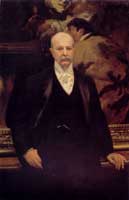|
The Satyr and the Peasant in
Juxtaposition
Q. I wonder what the old boy was up to,
having JSS put that in the background!
What an interesting puzzle indeed. I think there are a couple of
different things that could be going on.
We know that Peter Widener was quite wealthy and he had been an art
collector for some time. His house at Lynnewood Hall was filled with
some major pieces of old Grand Masters (which would later be donated by
his son – many of which ended up at the National Gallery of Art). For
Sargent to take the time to copy and study these old wonderful works of
the Masters is an opportunity I’m sure he availed himself. In the
process of copying one of these works Sargent might have suggested to
Peter that he stand in front – “Peter, why don’t you stand here
and let me paint you again?” It might have been that simple.
There is some evidence that something like this may have happened. When
the painting
 |

 MFA
at Copley Square MFA
at Copley Square
1st
site for Museum

|
was exhibited
at the Museum of Fine Arts (the old Copley Square building) in June of
that year (’03), a reviewer for the Boston
Transcript found the background (the Johann Liss’ painting) to
be in conflict with the main figure and not subdued enough for what
would be expected of a typical portrait. Peter Widener, it said was
“Extremely fine,” but the impasto of the background “seems to us hardly
flat enough: it disturbs by its relief, in spite of its unquestionably
fine tonality.” (Boston Evening Transcript, June 12,
1903, n.p.; quoted in John Singer Sargent, The Later Portraits ;Ormond
and Kilmurray; Yale University, 2003; p. 116)
Another explanation, just as plausible to my mind, is that Sargent
hadn’t quite figured out how to complete his composition. You can see
that there is evidence of a picture frame above
Peter’s head – upper left corner. Sargent would often flank his
 |


Mrs. John J. Chapman
(Elizabeth Winthrop Chanler)
1893

|
sitters with
paintings. The portrait of Mrs. John
J. Chapman is a good example. Maybe Sargent changed his mind in
midstream. The painting of The Satyr
and the Peasant appears
to be the beginning of a painting over of the smaller picture frame
idea. Besides the clear representation of the “Peasant” you can see the
beginnings of the clothing of the wife above Widener’s head AND – look
closely – the beginning of the Satyr’s hand which begins to cover the
right side of the smaller frame.
Now, to spice this delicious story even further, apparently Peter had
bought The Satyr and the Peasant
in 1897 under the assumption that it was a work by the Great Master
Valazquez, not a Johann Liss. (Ormond and Kilmurray,
p.115) It seems that Peter Widener had been bamboozled by art
dealers who "blow hot and cold with the same breath!"
Since this less formal portrait of Peter had never been intended, if my
assumption is correct, maybe this was given as a gift which explains
its unfinished nature. Both men might have liked the inside joke. There
was
really no need to finish painting in the Satyr -- Peter is the Satyr.
John Singer
Sargent

Peter A. B. Widener
1903
(behind the figure is The Satyr and the Peasant
owned by Peter Widener)
Note:
|

